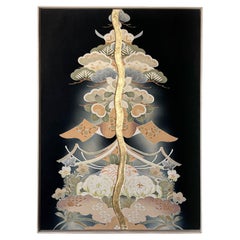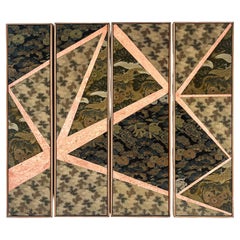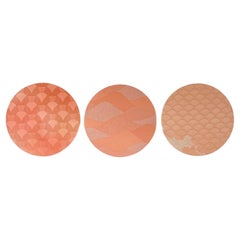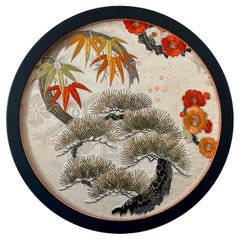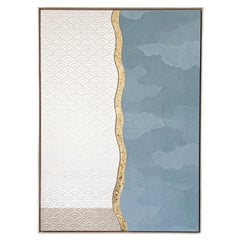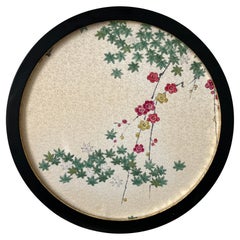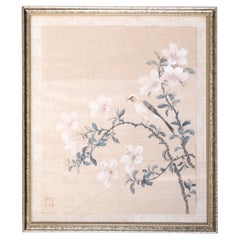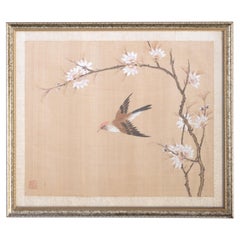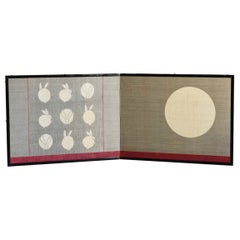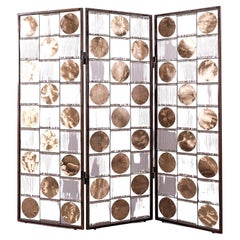Woven Paintings and Screens
to
4
22
1
1
1
20
4
6
9
1
1
5
5
2
22
19
16
7
6
20
20
18
1
1
22
22
22
18
Technique: Woven
Antique kimono textile art "Prosperity Tree" by ikasu Black, Japan
By Kimono ikasu
Located in Setagaya City, JP
This work uses an antique kimono fabric dated Taisho era (early 1910th), with a pine tree motif, and arranges it so that it looks like a tree decorated with various auspicious symbols - persimmons, pines, peonies, etc.
The line in the middle symbolizes “kintsugi” - concept of wabi-sabi, which values imperfection, impermanence, and the beauty of aging.
It is elegantly framed with paulownia wood originally used for kimono chest-of-drawers, and is filled with storytelling and sense of luxury.
I used pieces of kimono that could no longer be used as clothing and kiritansu chest-of-drawers that would normally be discarded to create the ultimate upcycled piece.
<< Explanation and meaning of pattern and colors >>
The art work features the matsu - pine pattern, which depicts the Japanese pine tree spreading over deep black fabric. It appears as if the pine dranches are decorated with various auspicious symbols - persimmons, pines, peonies, etc.
In East Asia, the pine tree is revered as a symbol of longevity due to its vibrant green leaves, even during the winter season.
In Japan, it's often referred to as the "evergreen tree" because its leaves remain green throughout the year, making it a symbol of good fortune that has been cherished for a long time.
<< Characteristics of the fabric >>
The fabric is hand-painted in traditional Japanese technique "yuzen".
<< About the frame >>
Kiritansu - chest-of-drawers for kimono, is traditionally made from paulownia wood, a uniquely Japanese material closely tied to the world of kimonos.
Paulownia wood is known as the lightest wood in Japan, prased for its natural luster, resistance to moisture, and resilience against cracking. Since ancient times, it has been used in crafting furniture, chests, and musical instruments.
During the Edo period, it became customary to store cherished kimonos in paulownia chests...
Category
Early 20th Century Japanese Japonisme Woven Paintings and Screens
Materials
Gold Leaf
Antique obi textile art " Pine forest ~ Longivety ~ " by ikasu Green , Japan
By Kimono ikasu
Located in Setagaya City, JP
<< Story behind the work >>
Obi fabric I used for this artwork is taken from three different over 100-years-old antique sashes, and is framed in wood taken from antique chest-of-dra...
Category
Early 20th Century Japanese Japonisme Woven Paintings and Screens
Materials
Gold Leaf
Vintage kimono textile art "On Coral Waves ~Everlasting~" by ikasu Pink, Japan
By Kimono ikasu
Located in Setagaya City, JP
<< About this canvas >>
This kimono canvas set of three pieces portrays mountains surrounded by the sea. While each of the three pieces is crafted from different kimonos, they all s...
Category
1970s Japanese Japonisme Vintage Woven Paintings and Screens
Materials
Silk, Canvas
Antique obi textile art " View from the Window ~ Shochikubai ~ " by ikasu, Japan
By Kimono ikasu
Located in Setagaya City, JP
This work is a glorious nod to buddhist temples circle windows, with beautiful Japanese garden scape seen outside. Golden leaf on the border of a frame is an expression of light goin...
Category
1910s Japanese Japonisme Vintage Woven Paintings and Screens
Materials
Gold Leaf
Vintage kimono textile art " Seaside ~ Kintsugi ~ " by ikasu White/Blue Japan
By Kimono ikasu
Located in Setagaya City, JP
This work is inspired by the sea and the sky, uses golden leafing as a creative point, framed in paulownia wood originally used for a kimono chest-of-drawers.
In this artwork, the aim was to capture the splendor of Japanese nature, showing the sea, sky, and forests. Traditional Japanese culture, represented by the kimono, and wood, an integral element of Japanese craftsmanship, were used to bring this vision to life.
I used two pieces of kimono that could no longer be used as clothing and bark that would normally be discarded to create the ultimate upcycled piece.
The marriage of Japanese natural materials - silk, paulownia (frame), and pine (branch slices for the center decoration) - and Japanese natural patterns - blue ocean waves and clouds - expresses the magnificent beauty of Japanese nature from various angles.
The central golden leaf decoration stands out as a distinctive feature of this work. The piece uses the concept of "kintsugi" - it "unites" the pieces of antique kimono back together with golden leaf to give it a second wind as art work.
<< Period / Story >>
The kimono used in this piece was originally crafted during the late Showa period (1960-80ies).
<< Explanation and meaning of pattern and colors >>
The kimonos on this canvas have been creatively repurposed into interior artwork. The one on the left represents ocean wave pattern.
Seigaiha waves is regarded as a pattern of good fortune, embodying wishes for eternal happiness and a tranquil life for future generations.
The fabric on the right is embellished with cloud patterns woven in various techniques. Clouds, with their ever-shifting shapes and colors, have long intrigued people as signs of big events or omens.
<< Characteristics of the fabric >>
The kimono used for a part on the left has a lustrous, ivory-colored ground that serves as a backdrop for the vibrant ocean wave pattern expressed through the ground pattern.
On the right fabric, the cloud pattern is beautifully rendered by dyeing both the plain fabric and delicate patterns. This is achieved through the so-called "Yose-komon" technique, where each cloud is adorned with small patterns such as hail, sharks skin pattern, and other intricate details.
Edo komon, created using a refined and advanced dyeing technique that appears as a solid color from a distance, originated during the Edo period (1603-1868) and remains highly popular as formal kimono attire to this day.
<< About the frame >>
Kiritansu - chest-of-drawers for kimono, is traditionally made from paulownia wood, a uniquely Japanese material closely tied to the world of kimonos.
Paulownia wood is known as the lightest wood in Japan, prased for its natural luster, resistance to moisture, and resilience against cracking. Since ancient times, it has been used in crafting furniture, chests, and musical instruments.
During the Edo period, it became customary to store cherished kimonos in paulownia chests...
Category
Late 20th Century Japanese Japonisme Woven Paintings and Screens
Materials
Gold Leaf
Vintage kimono textile art "View from the Window ~Maple&Plum~" by ikasu, Japan
By Kimono ikasu
Located in Setagaya City, JP
This work is a glorious nod to buddhist temples circle windows, with beautiful Japanese garden scape seen outside. Golden leaf on the border of a frame is an expression of light goin...
Category
1930s Japanese Japonisme Vintage Woven Paintings and Screens
Materials
Gold Leaf
VIntage kimono textile art " Wish for prosperity " by ikasu Gold, Black, Japan
By Kimono ikasu
Located in Setagaya City, JP
This work is inspired by traditional Japanese nature colors symbolism, and is framed in paulownia wood originally used for a kimono chest-of-drawers.
It is filled with storytelling ...
Category
1960s Japanese Japonisme Vintage Woven Paintings and Screens
Materials
Silk, Wood
Vintage kimono textile art "Sunset Timelapse ~Ephemerality~" by ikasu Red, Japan
By Kimono ikasu
Located in Setagaya City, JP
The art piece uses two sides - front and reverse - of the same kimono, to show beautiful sea surrounding Japan, in hues and in late sunset, as a timelapse.
The frame for this work is made of paulownia wood taken from antique Kiritansu - chest-of-drawers for kimono.
I use antique kiritansu that can’t be used as furniture anymore to create basis and frames for my works. It adds them even more authentic atmosphere of traditional wabisabi spirit. Can you feel it?
<< Period / Story >>
The kimono used in this piece was originally crafted during Showa period (around 1960ies).
<< Explanation and meaning of pattern and colors >>
Sea waves, depicted in two color variations here, are a symbol of transience and Impermanence in Japanese culture. The ebb and flow of the tides, the ever-changing currents, and the relentless motion of the waves serve as reminders of the fleeting nature of life. This artwork featuring the sea convey themes of impermanence, reminding viewers to cherish the present moment and appreciate the beauty of life's fleeting moments.
The theme of impermanence is strengthen by two colors of the sea - the lighter in early hues and the darker when the sun is just about to set in the sea.
<< About the frame >>
This artwork frame is crafted from paulownia wood, a uniquely Japanese material closely tied to the world of kimonos, and it serves to convey the refined beauty of Japanese nature.
Paulownia wood is known as the lightest wood in Japan, prased for its natural luster, resistance to moisture, and resilience against cracking. Since ancient times, it has been used in crafting furniture, chests, and musical instruments.
Paulownia wood is closely linked to kimono culture. During the Edo period (17th cent.~), it became customary to store cherished kimonos in paulownia chests...
Category
1960s Japanese Japonisme Vintage Woven Paintings and Screens
Materials
Silk, Wood
Vintage kimono textile art " Turquoise Forest ~Strength~ " by ikasu Blue, Japan
By Kimono ikasu
Located in Setagaya City, JP
Fabrics featuring iconic Japanese plants like chrysanthemum, maple, and bamboo were gathered from various long underwear and kimono pieces to create a set of canvases (diameter 30, 25 and 20cm) showcasing exquisite gradations.
The top canvas, in pristine white, originates from long under-kimono, while the middle and bottom canvases are skillfully upcycled from kimono fabrics.
<< Period / Story >>
The long under-kimono and kimono fabrics used in these canvases were originally crafted and worn during the late Showa period (1960-80ies).
<< Explanation and meaning of pattern and colors >>
The pattern on the top canvas features a chrysanthemum, an auspicious emblem symbolizing longevity. It is affectionately referred to as the "raccoon dog chrysanthemum" due to the large, overlapping petals resembling the fur of a muzina, a creature similar to a raccoon dog or badger. This motif is highly popular in various plant-inspired designs and frequently seen in Edo komon, katazome, and jimon textiles.
The top canvas naga-juban under-kimono, being entirely white and devoid of any additional dyes, suggests its use as formal wear. Its pristine white hue accentuates the silk's luster when exposed to light and highlights the beauty of the woven patterns.
The fabric used here is rinzu, a type of fabric thinner than crepe de chine, characterized by its soft, smooth texture and subtle sheen. This particular lintel distinguishes itself with the way its ground pattern emerges and also incorporates a woven chrysanthemum pattern.
The central canvas showcases a maple tree, symbolizing longevity, which changes its colors with the seasons, bringing joy and happiness to people's lives.
The bamboo featured on the lower canvas has been regarded as a symbol of good fortune since ancient times, given its straight and vigorous growth, along with the Chinese legend that a phoenix consumes its fruit. It embodies concepts such as "immortality," "longevity," and "strength" because it remains green even in winter. The hollow stem also signifies "innocence," suggesting that there are no hidden agendas.
All three canvases are adorned with ground patterns that, when viewed from a distance, appear as modern works of art, yet upon closer inspection, they reveal a distinct Japanese ambiance.
<< Characteristics of the fabric >>
All three canvases are made of fabrics with jimon. The unique and high level of Japanese weaving...
Category
1970s Japanese Japonisme Vintage Woven Paintings and Screens
Materials
Canvas, Silk
Vintage obi textile art " Moon phase II " by ikasu Silver, Black, Japan
By Kimono ikasu
Located in Setagaya City, JP
<< About this artwork >>
This artwork has been upcycled from a stunning obi, which is adorned with calligraphy weaving saying "moon" and "moonlight".
<< Period / Story >>
The obi...
Category
1970s Japanese Japonisme Vintage Woven Paintings and Screens
Materials
Silver Leaf
VIntage kimono textile art " Monochrome Geometry " by ikasu Gold, Grey, Japan
By Kimono ikasu
Located in Setagaya City, JP
This work is inspired by traditional Japanese nature colors symbolism, and is framed in paulownia wood originally used for a kimono chest-of-drawers.
It is filled with storytelling ...
Category
1960s Japanese Japonisme Vintage Woven Paintings and Screens
Materials
Silk, Wood
Vintage kimono textile art "Snowflake ~New Beginnings~" by ikasu Purple, Japan
By Kimono ikasu
Located in Setagaya City, JP
Six canvases (Diameter approx. 30cm, 25cm, 20cm) use the fabric taken from antique kimono, its' various parts, to create one harmonious fluid image of a snowflake - a symbol of new b...
Category
1970s Japanese Japonisme Vintage Woven Paintings and Screens
Materials
Canvas, Silk
VIntage kimono textile art "Geometry ~Marble~" by ikasu Gold, White, Grey, Japan
By Kimono ikasu
Located in Setagaya City, JP
This work is inspired by traditional Japanese nature motifs symbolism, and is framed in paulownia wood originally used for a kimono chest-of-drawers.
It is elegantly framed with pau...
Category
1960s Japanese Japonisme Vintage Woven Paintings and Screens
Materials
Silk, Wood
Vintage kimono textile art " Plum Gradation " by ikasu Pink, White, Japan
By Kimono ikasu
Located in Setagaya City, JP
This canvas featuring a plum color gradient kimono showcases a unique decorative variation of the popular seigaiha (青海波) sea waves pattern.
The artwork got a Mr. & Mrs. Abe Arts & Cu...
Category
1980s Japanese Japonisme Vintage Woven Paintings and Screens
Materials
Canvas, Silk
Vintage obi textile art "Under the Sun ~Serendipity " by ikasu Red / Beige Japan
By Kimono ikasu
Located in Setagaya City, JP
This artwork creatively uses tree bark to evoke the imagery of woods and mountains during both the morning and nighttime on left and right. It is elegantly framed with paulownia wood, a tree closely connected to kimono culture, and is filled with storytelling and sense of luxury.
By incorporating both the front and back sides of the same obi fabric woven in different colors, the play of light and shadow on the mountains is depicted through the contrasting appearances of these surfaces.
The intention behind this piece is to convey the exquisite beauty of Japanese mountains and the lush forests that inhabit them. To achieve this, traditional elements of Japanese culture, such as obi textiles and craftsmanship involving wood, were used.
The outer side and inner linings of the same obi, no longer suitable for clothing, along with bark material that would normally be discarded, have been repurposed to create this exceptional upcycle artwork.
The fusion of Japanese natural materials – silk, paulownia wood, and pine bark for the central decoration – along with the so-called "Tozan" pattern, a unique Japanese natural design showing mountains from far-away point, captures the magnificent beauty of Japanese nature from various perspectives.
The central bark decoration stands out as a distinctive feature of this work. Pine, oak, and other tree barks are interwoven among the mountains woven into the obi, creating a tangible and authentic natural atmosphere.
<< Period / Story >>
The obi used in this piece was originally crafted during the late Showa period (1960-80ies).
<< Explanation and meaning of pattern and colors >>
This upcycle artwork uses an obi with a tozan pattern woven in two colors. The design is inspired by a distant mountain range, a motif that has been used in paintings and crafts since ancient times. However, in this particular design, the mountains are depicted not as distant peaks but as graceful semicircles giving it a mild atmosphere.
<< Characteristics of the fabric >>
This upcycled Fukuro-obi (two-side obi) showcases a festive color pattern of mountains intricately woven with gold threads against a beige front and red on the back.
The way this obi interacts with light allows it to shift in expression, much like a mountain revealing different facets over time. It can transform from deep shades of color to the appearance of gold shimmering against bright hues, depending on the lighting and viewing angle.
<< About the frame >>
Kiritansu - chest-of-drawers for kimono, is traditionally made from paulownia wood, a uniquely Japanese material closely tied to the world of kimonos.
Paulownia wood is known as the lightest wood in Japan, prased for its natural luster, resistance to moisture, and resilience against cracking. Since ancient times, it has been used in crafting furniture, chests, and musical instruments.
During the Edo period, it became customary to store cherished kimonos in paulownia chests...
Category
Late 20th Century Japanese Japonisme Woven Paintings and Screens
Materials
Silk, Wood
Vintage kimono textile art "Flowers ~Life Circle~" by ikasu Pink, Black, Japan
By Kimono ikasu
Located in Setagaya City, JP
<< About this canvas >>
This canvas is crafted from three different haori fabrics, each adorned with a shibori dyeing flower motif going through entire fabric. These fabrics tell a ...
Category
1970s Japanese Japonisme Vintage Woven Paintings and Screens
Materials
Canvas, Silk
VIntage kimono textile art "Geometry ~Chrysanthemums" by ikasu, white, red Japan
By Kimono ikasu
Located in Setagaya City, JP
This work is inspired by traditional Japanese natural symbolism, and is framed in paulownia wood originally used for a kimono chest-of-drawers.
It is elegantly framed with paulownia...
Category
1960s Japanese Japonisme Vintage Woven Paintings and Screens
Materials
Silk, Wood
Japanese Six Panel Screen: Waka Poems on Basketry Design
Located in Hudson, NY
Ribbons of 17th century calligraphy poems are mounted on an 18th century screen with a woven bamboo motif. These poems are aristocratic Waka poem...
Category
17th Century Antique Woven Paintings and Screens
Materials
Gold, Bronze, Gold Leaf
c. 1800 English Fire Pole Screen Needlepoint/Tapestry Stand
Located in Louisville, KY
Unique and finely made, this English Regency pole screen is constructed of beautiful Rosewood that’s hand-turned, carved and jointed, topped with a delicate finial with three cabriol...
Category
Early 19th Century English Regency Antique Woven Paintings and Screens
Materials
Textile, Wood, Rosewood
Asian Chinese Ancient Warriors Hand-Painted
Located in WEST PALM BEACH, FL
These stunning paintings of ancient warriors in full costume offer a dramatic and colorful palate for a room decor, circa 1950.
Category
20th Century Chinese Other Woven Paintings and Screens
Materials
Fabric, Paint
Vintage obi textile art "Broken Vase ~kintsugi~" by ikasu Black / Gold, Japan
By Kimono ikasu
Located in Setagaya City, JP
This textile artwork uses a vintage obi dated around 1980ies, with a feather motif, and arranges it so that it looks like a vase.
Antique obi, just as it is a broken vase, is united back again with black obijime - a string used to tie up obi when it’s worn. Framed in kiritansu (antique chest) paulownia wood.
It is elegantly framed with paulownia wood originally used for kimono chest-of-drawers, and is filled with storytelling and sense of luxury.
I used pieces of kimono that could no longer be used as clothing and kiritansu chest-of-drawers that would normally be discarded to create the ultimate upcycled piece.
<< Explanation and meaning of pattern and colors>>
Feathers hold various meanings and symbolism in Japanese traditional culture, often reflecting themes of spirituality, symbolism, and folklore. Here are some of the meanings associated with feathers in Japanese tradition:
・Divine Protection: Feathers are often seen as symbols of divine protection and spiritual guidance. Feathers, especially those from birds, are considered to be imbued with the protective energy, offering spiritual guardianship and safeguarding against negative forces.
・Connection to the Spirit World: Feathers are sometimes associated with the spirit world and the realm of the divine. In folklore and mythology, feathers are depicted as messengers between the earthly realm and the celestial realms.
・Symbol of Beauty and Elegance: Feathers are admired for their natural beauty, grace, and elegance. In traditional Japanese arts such as Noh theater, Kabuki, and dance performances like Kagura, actors and performers often use feathered costumes or accessories to enhance their appearance and convey a sense of refinement and sophistication.
・Sign of Good Luck and Prosperity: In Japanese folklore, certain birds like cranes and pheasants are considered symbols of good fortune, longevity, and prosperity. Feathers from these birds are often depicted in art and craftwork as auspicious symbols believed to bring blessings and positive energy to the bearer.
<>
Kiritansu - chest-of-drawers for kimono, is traditionally made from paulownia wood, a uniquely Japanese material closely tied to the world of kimonos.
Paulownia wood is known as the lightest wood in Japan, prased for its natural luster, resistance to moisture, and resilience against cracking. Since ancient times, it has been used in crafting furniture, chests, and musical instruments.
During the Edo period, it became customary to store cherished kimonos in paulownia chests...
Category
1980s Japanese Japonisme Vintage Woven Paintings and Screens
Materials
Silk, Wood
Early 20th Century Tibetan Thangka
Located in Hudson, NY
This fine vintage painted work is richly filled with small figures surrounding a large central figure. All interspersed with clouds and religious symbols. The colors are deep but muted with time and age. The piece is newly bordered in rich Chinese silks edges in three strong colors setting the piece of nicely and making a strong impression. The Thangka is framed overall in a gilded simple frame.
Condition Disclosure:
While we do our best to carefully inspect and give a full report on the condition
of any item we sell, pointing out any repairs or alterations that may have been
done to the best of our knowledge, as is the case with any antique and vintage item,
there is a possibility that at some point in the life of the piece that there
may have been damaged which has been professionally repaired and
as such a repair undetectable, it is therefore impossible for us to disclose...
we recommend that you also read and agree to the 1st dibs user agreement...
Category
Early 20th Century Tibetan Woven Paintings and Screens
Materials
Silk, Wood, Paint
Related Items
Vintage Framed Japanese Watercolour on Silk Signed C.1960
Located in London, GB
Vintage Framed Japanese Watercolour on Silk Signed C.1960
Depicting cherry blossom, the national flower of Japan, and a seated sparrow, a symbol of loyalty, friendship and prosperity...
Category
Mid-20th Century Japanese Woven Paintings and Screens
Materials
Silk, Paint
Vintage Framed Japanese Watercolour on Silk Signed C.1960
Located in London, GB
Vintage Framed Japanese Watercolour on Silk Signed , C.1960
Depicting cherry blossom, the national flower of Japan, and a sparrow in flight, a symbol of loyalty, friendship and prosp...
Category
Mid-20th Century Japanese Woven Paintings and Screens
Materials
Silk
Japanese Showa Four Panel Screen Fall Persimmon Tree
Located in Rio Vista, CA
Beautifully weathered Japanese Showa period four-panel byobu screen depicting a persimmon tree in the fall. Ink and natural color pigments on light gold silk background. Made in the ...
Category
20th Century Japanese Showa Woven Paintings and Screens
Materials
Brass
Japanese Antiques Silver folding screen, 2-panel set, bamboo, and plum
Located in Niiza, JP
Unfolded size: 1520 x 1530 x 20 mm
Foldable: 760 x 1530 x 40 mm, 5 kg
Estimated size after packaging (sandwiched between 5 mm plywood): 10 CM x 85 CM x 170 CM 22 KG
The pine, bamboo...
Category
20th Century Asian Woven Paintings and Screens
Materials
Paper
H 60.24 in W 59.85 in D 0.79 in
Japanese Showa Two Panel Screen Blossoming Prunus Tree
Located in Rio Vista, CA
Serene Japanese Showa period two-panel folding byobu screen depicting a large spring blossoming prunus tree or plum tree. Beautifully painted with ink and natural color pigments on m...
Category
20th Century Japanese Showa Woven Paintings and Screens
Materials
Brass
17th Century Japanese Screen. Ink Plum Tree & Birds by Kano Naonobu.
Located in Kyoto, JP
Kano Naonobu (1607-1650)
Plum Tree and Birds
Six-fold Japanese Screen. Ink and slight color on paper.
In this evocative ink work spread over a six-panel folding screen, we see the consummation of the elegance and refinement of the Edo Kano school. This 17th century screen is a rare surviving example of a large-scale bird and flower painting by Kano Naonobu, the younger brother of Kano Tanyu...
Category
17th Century Japanese Edo Antique Woven Paintings and Screens
Materials
Wood, Paper
Early 20th Century Japanese Nihonga Screen. Bamboo Forest.
Located in Kyoto, JP
Anonymous
Bamboo Forest
Early Taisho era. Circa 1910-1915.
Six-panel Japanese Screen. Mineral pigment, gofun and ink on silk.
A six-panel Japanese folding screen, painted on silk in...
Category
Early 20th Century Japanese Taisho Woven Paintings and Screens
Materials
Silk
Abstract Stone Sculpture by Unknown Artist from Japan
Located in Sammu-shi, Chiba
A stone object of unknown author from Japan. The stone is carved and polished. Very attractive shape and high quality nice work.
Category
Late 20th Century Japanese Mid-Century Modern Woven Paintings and Screens
Materials
Stoneware
China Natural Stone "Painting" Seaside Along White and Gray Mountains
Located in South Burlington, VT
Chinese extraordinary natural stone & with custom hardwood frame
"Seaside White and Gray Mountains" #2
This Chinese extraordinary natural stone "painting" of a mountain range in white and gray colors is called a dream stone Shih-hua. They are cut from historic Dali marble found in the Cangshan mountains of western China. These mysterious mountains, unique in the world, are known for yielding incredible and fantastic natural landscaped works of art created over tens of millions of years from mineral inclusions that affected the process of ancient organic material which transformed into limestone and finally resulted in marble- a metamorphic hard stone.
This art form is centuries of years old since the Ming dynasty. Dream stones became favored art in the west particularly since the 19th century when French collectors named them Pierres de reve.
This thin marble stone "painting" is approximately 1/4" thick and is cut from a large slab of rough material revealing incredible patterns in soft white and gray colors. Its weight is surprisingly modest- easily hung with standard hardware.
On occasion, private collectors would invite an artisan to inscribe a poetic description onto their more important dream stones and in this case the artists' seal mark and calligraphy translation reads:
Beautiful Custom Arts & Crafts hardwood frame
Dimensions:
Frame: 10.75 inches high and 15 inches wide.
Site: 6.25 inches high and 10.5 inches wide.
Provenance: Private Chinese collection, Yunnan, China.
History of "White and Gray" dream stone paintings:
“White and Gray” dream stone paintings known in China as Shui Mo or Chinese painting stone, were cut from stone found on Shuang Yang mountain in Dali mountains Captivating compositions, they might remind us of a long string of rugged mountain caps from a distance. These dream stones are cut from a scarce regional stone yielding notoriously “fuzzy” detailed paintings. To find examples possessing clear, contrasting detail like this one is indeed a rare find. Fine stone paintings like this example are rare as access to and availability of resource material diminishes. After a thin coating of wax is carefully applied to its surface to protect and reveal its beautiful subtle colors, this stone painting is signed upper right position with poetic verse and seal of an artisan who describes its majestic beauty.
Reference: Dreaming of Dreamstones China’s Extraordinary Natural Stone Paintings, Schneible Fine Arts. Dreaming of Dreamstones – World’s first comprehensive English text publication covers China’s extraordinary natural Stone Paintings, by author and dream stone lecturer Douglas Schneible, 35 pages, softcover, ISBN 978-0-578. See photos.
We have been dealing in authentic Chinese natural stone paintings...
Category
Late 20th Century Chinese Woven Paintings and Screens
Materials
Marble
Japanese Antiques Silver folding screen, 6-panel , cranes and pine
Located in Niiza, JP
Silver folding screen, 6-panel half-pair, cranes and pine
Size when unfolded: 3180 x 1530 x 17 mm
Can be folded: 530 x 1530 x 100 mm. 8kg
Estimated size after packaging (sandwiched...
Category
20th Century Japanese Woven Paintings and Screens
Materials
Paper
Japanese Modernist Painting of a Seaside Village by Torao Ataka Dated 1930
Located in San Francisco, CA
A Modern oil painting of a harbor town with the water and mountains views in the distance.
It is signed on the bottom left hand corner Ataka and dated '30 (1930).
The brushwork is ...
Category
1930s Japanese Modern Vintage Woven Paintings and Screens
Materials
Canvas, Paint
H 19.75 in W 24 in D 1.5 in
Japanese Antiques Hanging scroll, Pine and crane, silk
Located in Niiza, JP
Silk, scroll tip: resin
Size: Image size: 370 (W) x 1200 (H) [mm]
All : 500 (W) x 1930 (H) [mm]
Box size: 80 x 80 x 580 mm, 800g Tomo-bako(Original box)
Pine and crane, a Japanese...
Category
20th Century Japanese Woven Paintings and Screens
Materials
Silk
Previously Available Items
Japanese Folding Screen with Moon and Rabbit Drawn on Cloth/Old Partition/20th
Located in Sammu-shi, Chiba
This is an old Japanese folding screen.
It is an item made by dyeing cotton cloth instead of drawing directly on paper or silk.
The moon and rabbits are represented.
The moon and ...
Category
Mid-20th Century Japanese Taisho Woven Paintings and Screens
Materials
Cotton
H 26.42 in W 66.54 in D 0.71 in
Contemporary Valentina Giovando Screen Iron Brass Crystal Gold Bronze
Located in Milano, IT
Sutra love
Sutra Love is a foldable screen from the "Sutra" Collection.
The structure is an iron frame, the decoration is made of hand-cut round brass discs, rows of crystal stra...
Category
21st Century and Contemporary Italian Modern Woven Paintings and Screens
Materials
Crystal, Brass, Iron
H 73.23 in W 76.38 in D 1.58 in
Japanese Kyogen Noh Theater "TIGER & DRAGON" Dance Kimono Master work
Located in South Burlington, VT
From our recent Japanese Acquisitions Travels
Unique collectible opportunity- Immediately frameable
This 130 year old Japanese Kyogen Noh Theater Dance ...
Category
19th Century Japanese Meiji Antique Woven Paintings and Screens
Materials
Cotton
Japanese "Treasure Rabbits" Two-Panel Screen Taisho Period, 1915
Located in South Burlington, VT
Japan, a beautiful and unusual two-panel screen Byobu with seven hand embroidered Rabbits including -Treasure rabbits appliques -Shushu- applied to its cream colored paper surface an...
Category
Early 20th Century Japanese Taisho Woven Paintings and Screens
Materials
Fabric
Japanese Antique Two Panel Screen Hand Spun Tsutsugaki Wall Art, 19th Century
Located in South Burlington, VT
From our recent Japanese acquisitions travels- great wall art
A beautiful two panel screen created from a well-preserved futon cover tsutsugaki made of heavy cotton with the auspi...
Category
Late 19th Century Japanese Meiji Antique Woven Paintings and Screens
Materials
Cotton
H 70.5 in W 54.5 in D 2 in
Japanese 1890 Hand Spun Cotton "Chrysanthemum" Wall Art Bridal Gift Meiji Period
Located in South Burlington, VT
From our recent Japanese acquisitions travels- marvelous wall art
This is a fine Japanese 19th century hand spun, indigo dyed tsutsugaki chrysanthemums pattern hand drawn in the S...
Category
Late 19th Century Japanese Meiji Antique Woven Paintings and Screens
Materials
Cotton
H 51 in W 64.5 in D 0.01 in
Fine Woven Embroidered Silk Handmade Chinese Tapestry, 19th Century
Located in Sofia, BG
China made tapestry from 19th century 130 x 160cm woven and embroidered, Fine and coarse silk handmade.
Category
1880s Chinese Arts and Crafts Antique Woven Paintings and Screens
Materials
Silk
Japanese "Treasure Rabbits" Two-Panel Screen Taisho Period, 1915
Located in South Burlington, VT
Japan, a beautiful and unusual two-panel screen Byobu with seven hand embroidered Rabbits including -Treasure rabbits appliques -Shushu- applied to its cream colored paper surface an...
Category
Early 20th Century Japanese Taisho Woven Paintings and Screens
Materials
Fabric
Important Japanese "Moon Rabbits" Two-Panel Screen Taisho Period, 1915
Located in South Burlington, VT
Japan, a beautiful and unusual two-panel screen Byobu with nine hand embroidered Rabbits including fantastic -moon rabbits appliqués -Shushu- applied to it...
Category
Early 20th Century Japanese Taisho Woven Paintings and Screens
Materials
Fabric
Japanese Fine Vintage Hand Sewn Silk Kimono Quilt Wall Art, Pretty Pastels
Located in South Burlington, VT
An exceptionally fine quality Japanese hand sewn small fabric quilt wall art crafted from 19th-20th century Kimono fabric in the form of miniature kimono.
Pretty pastels.
It is imm...
Category
Mid-20th Century Japanese Woven Paintings and Screens
Materials
Silk
H 45 in W 33.5 in D 0.01 in
Japanese Fine Vintage Hand-Sewn Silk Kimono Quilt Wall Art Bold Colors
Located in South Burlington, VT
An exceptionally fine quality Japanese hand-sewn small fabric quilt wall art crafted from 19th-20th century Kimono fabric in the form of miniature kimono.
Bold colors.
It is im...
Category
Early 20th Century Japanese Showa Woven Paintings and Screens
Materials
Silk
Important Japanese Butterfly Four-Panel Screen Taisho Period, 1920
Located in South Burlington, VT
Japan, a beautiful and unusual four-panel screen Byobu with 12 hand embroidered Butterflies -Shushu- applied to its blue sky colored silk cloth surface and finished with a powdered g...
Category
Early 20th Century Japanese Taisho Woven Paintings and Screens
Materials
Fabric
